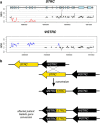Copy number variants are a common cause of non-syndromic hearing loss
- PMID: 24963352
- PMCID: PMC4067994
- DOI: 10.1186/gm554
Copy number variants are a common cause of non-syndromic hearing loss
Abstract
Background: Copy number variants (CNVs) are a well-recognized cause of genetic disease; however, methods for their identification are often gene-specific, excluded as 'routine' in screens of genetically heterogeneous disorders, and not implemented in most next-generation sequencing pipelines. For this reason, the contribution of CNVs to non-syndromic hearing loss (NSHL) is most likely under-recognized. We aimed to incorporate a method for CNV identification as part of our standard analysis pipeline and to determine the contribution of CNVs to genetic hearing loss.
Methods: We used targeted genomic enrichment and massively parallel sequencing to isolate and sequence all exons of all genes known to cause NSHL. We completed testing on 686 patients with hearing loss with no exclusions based on type of hearing loss or any other clinical features. For analysis we used an integrated method for detection of single nucleotide changes, indels and CNVs. CNVs were identified using a previously published method that utilizes median read-depth ratios and a sliding-window approach.
Results: Of 686 patients tested, 15.2% (104) carried at least one CNV within a known deafness gene. Of the 38.9% (267) of individuals for whom we were able to determine a genetic cause of hearing loss, a CNV was implicated in 18.7% (50). We identified CNVs in 16 different genes including 7 genes for which no CNVs have been previously reported. CNVs of STRC were most common (73% of CNVs identified) followed by CNVs of OTOA (13% of CNVs identified).
Conclusion: CNVs are an important cause of NSHL and their detection must be included in comprehensive genetic testing for hearing loss.
Figures



Similar articles
-
Detection and Confirmation of Deafness-Causing Copy Number Variations in the STRC Gene by Massively Parallel Sequencing and Comparative Genomic Hybridization.Ann Otol Rhinol Laryngol. 2016 Nov;125(11):918-923. doi: 10.1177/0003489416661345. Epub 2016 Jul 28. Ann Otol Rhinol Laryngol. 2016. PMID: 27469136 Free PMC article.
-
Evaluation of copy number variants for genetic hearing loss: a review of current approaches and recent findings.Hum Genet. 2022 Apr;141(3-4):387-400. doi: 10.1007/s00439-021-02365-1. Epub 2021 Nov 22. Hum Genet. 2022. PMID: 34811589 Review.
-
STRC Gene Mutations, Mainly Large Deletions, are a Very Important Cause of Early-Onset Hereditary Hearing Loss in the Czech Population.Genet Test Mol Biomarkers. 2018 Feb;22(2):127-134. doi: 10.1089/gtmb.2017.0155. Genet Test Mol Biomarkers. 2018. PMID: 29425068
-
DNA Diagnostics of Hereditary Hearing Loss: A Targeted Resequencing Approach Combined with a Mutation Classification System.Hum Mutat. 2016 Aug;37(8):812-9. doi: 10.1002/humu.22999. Epub 2016 May 6. Hum Mutat. 2016. PMID: 27068579
-
Utility of droplet digital PCR and NGS-based CNV clinical assays in hearing loss diagnostics: current status and future prospects.Expert Rev Mol Diagn. 2021 Feb;21(2):213-221. doi: 10.1080/14737159.2021.1887731. Epub 2021 Feb 26. Expert Rev Mol Diagn. 2021. PMID: 33554673 Review.
Cited by
-
De novo variants are a common cause of genetic hearing loss.Genet Med. 2022 Dec;24(12):2555-2567. doi: 10.1016/j.gim.2022.08.028. Epub 2022 Oct 4. Genet Med. 2022. PMID: 36194208 Free PMC article.
-
A proposal for comprehensive newborn hearing screening to improve identification of deaf and hard-of-hearing children.Genet Med. 2019 Nov;21(11):2614-2630. doi: 10.1038/s41436-019-0563-5. Epub 2019 Jun 7. Genet Med. 2019. PMID: 31171844 Free PMC article.
-
Analysis of TMIE gene mutations including the first large deletion of exon 1 with autosomal recessive non-syndromic deafness.BMC Med Genomics. 2022 Jun 16;15(1):133. doi: 10.1186/s12920-022-01287-9. BMC Med Genomics. 2022. PMID: 35710363 Free PMC article.
-
Dual-vector gene therapy restores cochlear amplification and auditory sensitivity in a mouse model of DFNB16 hearing loss.Sci Adv. 2021 Dec 17;7(51):eabi7629. doi: 10.1126/sciadv.abi7629. Epub 2021 Dec 15. Sci Adv. 2021. PMID: 34910522 Free PMC article.
-
Utility and limitations of exome sequencing as a genetic diagnostic tool for children with hearing loss.Genet Med. 2018 Dec;20(12):1663-1676. doi: 10.1038/s41436-018-0004-x. Epub 2018 Jun 15. Genet Med. 2018. PMID: 29907799 Free PMC article.
References
-
- Stenson PD, Mort M, Ball EV, Shaw K, Phillips AD, Coooper DN. The Human Gene Mutation Database: building a comprehensive mutation repository for clinical and molecular genetics, diagnostic testing and personalized genomic medicine. Hum Genet. 2014;133:1–9. doi: 10.1007/s00439-013-1358-4. - DOI - PMC - PubMed
-
- Verpy E, Masmoudi S, Zwaenepoel I, Leibovici M, Hutchin TP, del Castillo I, Nouaille S, Blanchard S, Lainé S, Popot JL, Moreno F, Mueller RF, Petit C. Mutations in a new gene encoding a protein of the hair bundle cause non-syndromic deafness at the DFNB16 locus. Nat Genet. 2001;29:345–349. doi: 10.1038/ng726. - DOI - PubMed
Grants and funding
LinkOut - more resources
Full Text Sources
Other Literature Sources
Molecular Biology Databases

